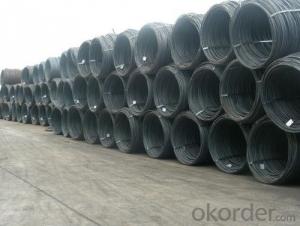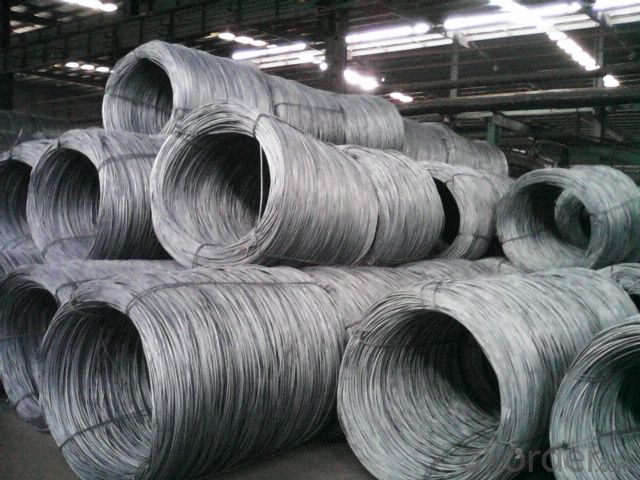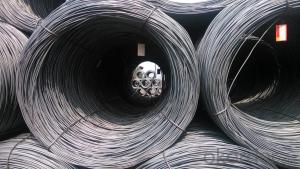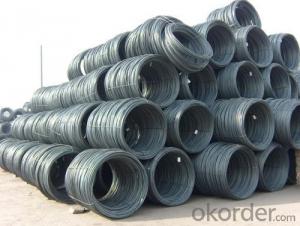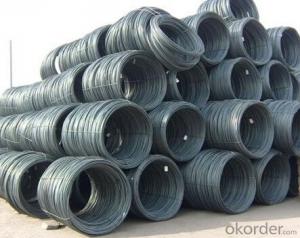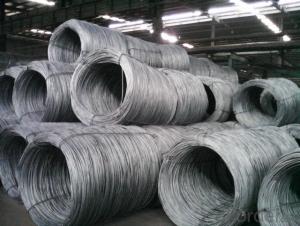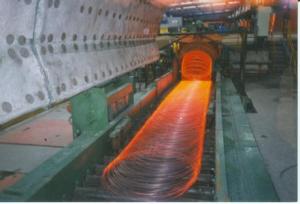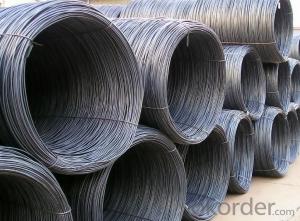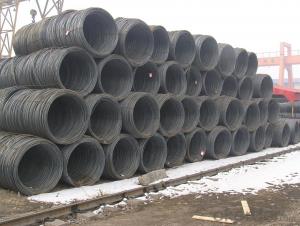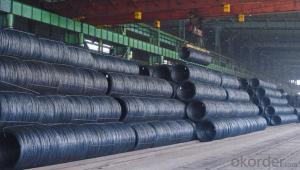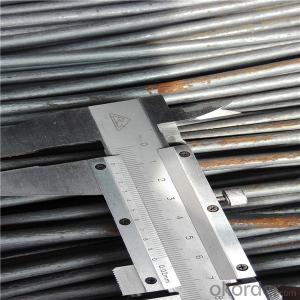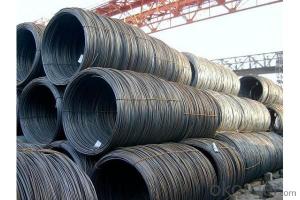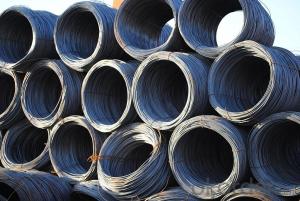Mild Steel Prime Hot Rolled Wire Rod in Coil
- Loading Port:
- China main port
- Payment Terms:
- TT OR LC
- Min Order Qty:
- 100 m.t.
- Supply Capability:
- 10000 m.t./month
OKorder Service Pledge
OKorder Financial Service
You Might Also Like
Specification
Product Description:
OKorder is offering Mild Steel Prime Hot Rolled Wire Rod in Coil at great prices with worldwide shipping. Our supplier is a world-class manufacturer of steel, with our products utilized the world over. OKorder annually supplies products to African, South American and Asian markets. We provide quotations within 24 hours of receiving an inquiry and guarantee competitive prices.
Product Applications:
Mild Steel Prime Hot Rolled Wire Rod in Coil are ideal for structural applications and are widely used in the construction of buildings and bridges, and the manufacturing, petrochemical, and transportation industries.
Product Advantages:
OKorder's Mild Steel Prime Hot Rolled Wire Rod in Coil are durable, strong, and wide variety of sizes.
Main Product Features:
· Premium quality
· Prompt delivery & seaworthy packing (30 days after receiving deposit)
· Can be recycled and reused
· Mill test certification
· Professional Service
· Competitive pricing
Product Specifications:
Manufacture: Hot rolled
Grade: Q195 – 235, SAE1008, SAE1006
Certificates: ISO, SGS, BV, CIQ
Packaging: Export packing, nude packing, in coil
Size: 5.5mm, 6.5mm, 7mm, 8mm, 9mm, 10mm, 12mm
Grade | Chemical Composition(%) | |||||
C | Mn | Si | S | P | Cr | |
SAE1006Cr | 0.03~O.07 | ≤0.32 | ≤0.30 | ≤0.045 | ≤0.040 | >0.3 |
Mechanical properties | ||||||
Yield strength(N/mm2) | Tensile strength(N/mm2) | Elongation(%) | ||||
250-280 | 350-380 | ≥32 | ||||
Grade | Chemical Composition(%) | |||||
C | Mn | Si | S | P | Cr | |
SAE1008Cr | 0.10max | 0.3~O.50 | 0.15max | 0.050max | 0.040 max | 0.3 min |
Mechanical properties | ||||||
Yield strength(N/mm2) | Tensile strength(N/mm2) | Elongation(%) | ||||
≥195 | 315-430 | ≥30 | ||||
Grade | Chemical Composition(%) | |||||
C | Mn | Si | S | P | Cr | |
Q195Cr | 0.06~O.12 | 0.25~O.50 | ≤0.30 | ≤0.050 | ≤0.045 | >0.3 |
Mechanical properties | ||||||
Yield strength(N/mm2) | Tensile strength(N/mm2) | Elongation(%) | ||||
≥195 | 315-430 | ≥33 | ||||
Grade | Chemical Composition(%) | |||||
C | Mn | Si | S | P | Cr | |
Q235Cr | 0.12~O.2 | 0.3~O.701 | ≤0.30 | ≤0.045 | ≤0.045 | >0.3 |
Mechanical properties | ||||||
Yield strength(N/mm2) | Tensile strength(N/mm2) | Elongation(%) | ||||
235 | 375-500 | ≥26 | ||||
FAQ:
Q1: Why buy Materials & Equipment from OKorder.com?
A1: All products offered byOKorder.com are carefully selected from China's most reliable manufacturing enterprises. Through its ISO certifications, OKorder.com adheres to the highest standards and a commitment to supply chain safety and customer satisfaction.
Q2: How do we guarantee the quality of our products?
A2: We have established an advanced quality management system which conducts strict quality tests at every step, from raw materials to the final product. At the same time, we provide extensive follow-up service assurances as required.
Q3: How soon can we receive the product after purchase?
A3: Within three days of placing an order, we will arrange production. The normal sizes with the normal grade can be produced within one month. The specific shipping date is dependent upon international and government factors, the delivery to international main port about 45-60days.
Images:
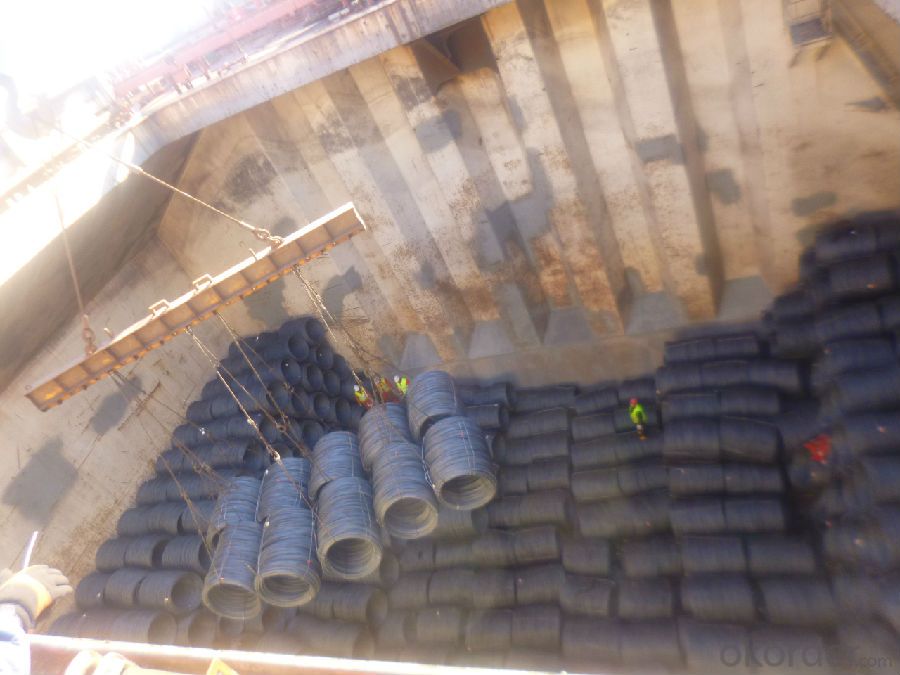
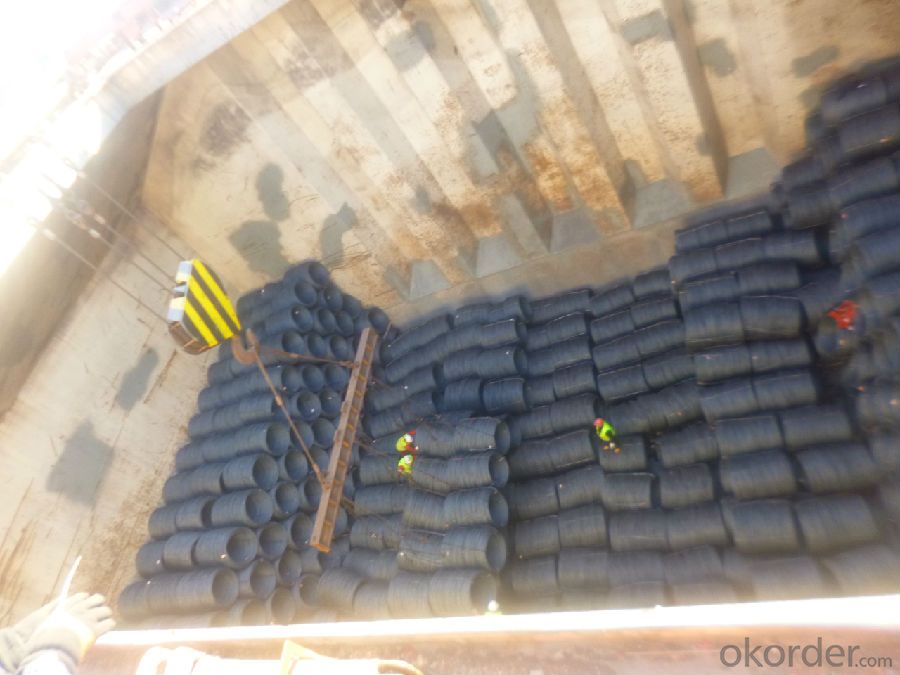
- Q: What are the main components of steel wire rod production equipment?
- The main components of steel wire rod production equipment typically include a reheating furnace, a rolling mill, a cooling bed, and various auxiliary equipment such as shearing machines, straightening machines, and bundling machines.
- Q: What are the standard impact strength requirements for steel wire rod?
- The impact strength requirements of steel wire rod can differ based on the specific application and industry standards. However, in general, steel wire rod needs to have good impact strength properties to ensure durability and resistance against breakage in dynamic loading situations. Various international standards organizations like ASTM International, ISO, and national standards bodies establish the impact strength requirements. These standards offer guidelines for determining the impact strength of steel wire rod through standardized testing methods. To fulfill the standard impact strength requirements, steel wire rod is often subjected to impact tests such as Charpy or Izod tests. These tests involve striking a notched sample of the wire rod with a pendulum hammer and measuring the energy absorbed during fracture. The results provide an indication of the material's ability to endure sudden shock or impact. The specific impact strength requirements for steel wire rod can differ based on factors such as the intended application, industry regulations, and customer specifications. For instance, wire rod used in construction may have different impact strength requirements compared to wire rod used in automotive manufacturing. In summary, the impact strength requirements for steel wire rod are determined by international and national standards organizations and can vary depending on the application. Complying with these requirements ensures that the wire rod possesses the necessary strength and resilience to withstand impact and dynamic loading conditions.
- Q: How are surface defects in steel wire rod classified?
- Surface defects in steel wire rod are classified based on their characteristics and appearance. Some common classifications of surface defects in steel wire rod include: 1. Scale: Scale defects occur when the steel wire rod is exposed to high temperatures during the manufacturing process and forms a layer of oxide on its surface. Scale defects may appear as a rough, flaky, or scaly surface and can negatively affect the wire's performance. 2. Pits: Pits are small depressions or cavities on the surface of the steel wire rod. They can be caused by various factors such as corrosion, improper handling, or manufacturing defects. Pits can weaken the wire's structural integrity and compromise its functionality. 3. Scratches: Scratches are superficial marks or grooves on the surface of the steel wire rod. They can occur during handling, transportation, or manufacturing processes. Although scratches may not significantly impact the wire's strength, they can affect its appearance and may lead to further corrosion if left untreated. 4. Cracks: Cracks are linear fractures that extend through the surface of the steel wire rod. They can be caused by improper cooling, excessive stress, or manufacturing defects. Cracks are considered severe defects as they can propagate and lead to catastrophic failure under load. 5. Inclusions: Inclusions are non-metallic particles or impurities embedded within the steel wire rod's surface. These can include slag, oxides, or foreign materials introduced during the manufacturing process. Inclusions weaken the wire's mechanical properties and can contribute to premature failure. 6. Decarburization: Decarburization is a process where the carbon content at the surface of the steel wire rod is reduced. It can occur due to improper heat treatment or exposure to high temperatures. Decarburization weakens the wire's hardness and can negatively impact its performance. 7. Lamination: Laminations are layers or separations within the steel wire rod that occur during the rolling process. They can be caused by inadequate bonding between layers or impurities within the steel. Laminations can weaken the wire's structure and compromise its mechanical properties. Classifying surface defects in steel wire rod is crucial for quality control and ensuring the wire's reliability and performance. By identifying and categorizing these defects, manufacturers can take appropriate measures to minimize their occurrence and improve the overall quality of the wire rod.
- Q: What are the common sizes of steel wire rods?
- The common sizes of steel wire rods vary depending on their intended use and application. However, some commonly available sizes range from 5.5mm to 32mm in diameter.
- Q: What are the common production processes for low carbon steel wire rod?
- The common production processes for low carbon steel wire rod include heating and melting the steel, followed by continuous casting to form billets. These billets are then rolled into wire rod through a series of hot rolling, cooling, and finishing processes. The wire rod is typically coiled and may undergo additional treatments like drawing, annealing, and surface coating before it is used in various applications.
- Q: What are the potential applications of stainless steel wire rod?
- The unique properties and versatility of stainless steel wire rod make it suitable for a wide range of applications. Some of these applications include: 1. Construction and infrastructure: Stainless steel wire rod is often used in construction and infrastructure projects due to its strength, durability, and resistance to corrosion. It can be utilized in the production of reinforcement bars, concrete structures, bridges, and other crucial infrastructure components. 2. Automotive industry: Stainless steel wire rod is employed in the manufacturing of different automotive components, such as exhaust systems, suspension springs, and engine parts. Its excellent resistance to heat, corrosion, and high temperatures makes it ideal for demanding automotive applications. 3. Aerospace industry: The lightweight nature and high strength-to-weight ratio of stainless steel wire rod make it suitable for the aerospace industry. It is used in the production of aircraft components, including fasteners, cables, and structural elements, where corrosion resistance and mechanical properties are vital. 4. Medical equipment: Stainless steel wire rod is widely used in the production of medical equipment and instruments due to its biocompatibility, corrosion resistance, and ease of sterilization. Surgical tools, implants, orthodontic wires, and other medical devices are made using stainless steel wire rod. 5. Power generation: The power generation industry utilizes stainless steel wire rod for its excellent resistance to high temperatures, pressure, and corrosion. It is commonly used in the production of turbine blades, heat exchangers, and other critical components in power plants. 6. Food processing industry: Stainless steel wire rod is extensively used in the food processing industry because of its hygienic properties and resistance to corrosion. It is employed in the production of food handling equipment, storage tanks, and processing machinery. 7. Wire products: Various wire products, such as springs, wire mesh, cables, and fencing, are made using stainless steel wire rod. Its high tensile strength, corrosion resistance, and flexibility make it suitable for these applications. 8. Marine industry: The marine industry relies on stainless steel wire rod for its resistance to corrosion in saltwater environments. It is used in the production of marine equipment, boat fittings, rigging, and other components. In conclusion, stainless steel wire rod has vast and diverse potential applications, spanning across industries such as construction, automotive, aerospace, medical, power generation, food processing, wire products, and the marine sector. Its exceptional properties make it a reliable and preferred material for critical applications that require strength, durability, and corrosion resistance.
- Q: What are the common production processes for alloy steel wire rod?
- The common production processes for alloy steel wire rod include melting and refining the raw materials, continuous casting to form a solid billet, hot rolling the billet into wire rod, followed by cooling, surface treatment, and final inspection and packaging.
- Q: What are the different types of steel wire rod surface defects and their repair methods?
- There are several types of steel wire rod surface defects, including scale, pitting, scratches, and cracks. Scale refers to the formation of oxide layers on the surface due to exposure to high temperatures during production. Pitting occurs as small depressions or holes on the surface, often caused by corrosion or impurities in the steel. Scratches are visible marks or grooves on the surface, commonly caused by handling or abrasive contact. Cracks are linear fractures that can occur due to various factors such as stress or improper cooling. To repair these defects, different methods are employed. Scale can be removed through processes like pickling or shot blasting to restore the smoothness of the surface. Pitting can be repaired by grinding or polishing the affected areas to reduce the depth of the pits. Scratches can be minimized through abrasive techniques, such as sanding or buffing, to level the surface. Cracks are more complex to repair and may require welding or heat treatment to restore the integrity of the wire rod. Overall, the repair methods for steel wire rod surface defects depend on the specific type and severity of the defect, with the ultimate goal of achieving a smooth, defect-free surface.
- Q: What are the different types of steel wire rod surface finishing processes?
- There are several types of steel wire rod surface finishing processes, including pickling, galvanizing, phosphating, electroplating, and powder coating.
- Q: What are the common production processes for darmstadtium-coated steel wire rod?
- The common production processes for darmstadtium-coated steel wire rod involve several steps. First, the steel wire rod is cleaned and prepared to ensure its surface is free from contaminants. Then, the darmstadtium coating is applied using a specialized deposition technique, such as physical vapor deposition or electroplating. After the coating, the wire rod is typically heat-treated to enhance adhesion and durability. Finally, the coated wire rod is inspected for quality and packaged for distribution.
Send your message to us
Mild Steel Prime Hot Rolled Wire Rod in Coil
- Loading Port:
- China main port
- Payment Terms:
- TT OR LC
- Min Order Qty:
- 100 m.t.
- Supply Capability:
- 10000 m.t./month
OKorder Service Pledge
OKorder Financial Service
Similar products
Hot products
Hot Searches
Related keywords
